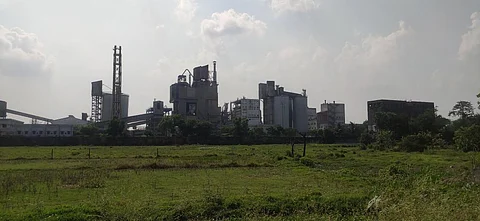

The air is burdened with heavy smoke and dust in Dhulagarh in West Bengal’s Howrah district. Villagers — as little as two-year-olds — have trouble breathing. Others grapple with skin allergies and eye infections.
A cement factory set up in 2000, villagers said, is the root of all evil. The novel coronavirus disease (COVID-19) pandemic has worsened the situation, making villagers with already weak immune systems more susceptible to the virus, said doctors.
As many as 15,000 people live across three villages in Dhulagarh — Mohisgot, Bhagwatipur, Chaturbhujkati — barely 18 km from Nabanna, the state administrative headquarters. The cement factory is located in the vicinity.
Farmers, too, have incessantly complained of a drop in quality of crops due to the pollution.
Children affected
Moumita Ari (28), a resident of Mohisgot village in Dhulagarh, has twin daughters aged 18 months. Both suffer from respiratory problems. She told Down to Earth that she is planning to relocate.
“My daughters have been suffering from respiratory problems since birth. They need a nebulizer (an inhaler to clear airways and tract infection) to deal with the ailment. The dust from the cement factory worsens their condition. But the lack of livelihood opportunities due to the novel coronavirus disease (COVID-19) has forced us to stay here,” she said.
Moumita Ari has 18-months-old twins, both of whom suffer from breathlessness. Photo: Gurvinder Singh
Nebulizers are essential commodities and can be found in nearly every household of the village, said Manoj Patra (43), a villager at Mohisgot.
“The dust emanating from the factory often makes it difficult to breathe. Every inch of our house is covered with the dust. Villages often turn into a thick cloud of dust with nothing visible beyond a few metres,” said Patra.
Basudev bor, a registered medical practitioner (RMP) in Mohisgot, said:
“We get around seven fresh cases every month of people facing breathlessness and skin allergy. It also includes children. We refer the serious causes to big hospitals as we do not have the requisite facilities to treat them here. The situation has become alarming during the pandemic.”
DTE contacted company officials, who refused to comment on the matter.
Severe pollution
Environmental activists claimed that they measured the Air Quality Index (AQI) of the area in January 2021 and found it to be much higher than the normal levels.
“We found that particulate matter (PM) 2.5 was 479.4 and PM 10 was 2,576.07 against the normal levels of 60 and 100 respectively. The particulate matter is dangerous and causes severe health ailments. We demand proper action to stop the pollution,” said Sourav Prakritibadi, an environmental activist.
“The factory management gave us an assurance in written two years ago but nothing has been done so far. We have heard that they are now planning to increase the annual production of cement from 2.4 metric tonnes to 3.4 metric tonnes which would make the situation worse.”
The local Block Development Officer (BDO) said he received a complaint from the villagers in this regard: “We will initiate action once COVID-19 restrictions are eased,” said Naziruddin Sarkar, BDO, Sankrail, under whose jurisdiction the area falls.
Respiratory ailments common
Villagers said respiratory diseases, skin allergy and eye strain were common among them. “It is difficult to find a person who has not been affected. But it often goes undiagnosed due to a lack of adequate health facilities,” said Mira Patro (40), a homemaker in Mohisgot.
“Our clothes, food and utensils remain covered with dust. Children are forced to eat the same unhygienic and polluted food,” she added.
Locals said it all began in 2000, when a private cement company set up their plant in 132 bighas of land.
“We were against the setting up of the factory and launched a protest then. But the administration went ahead with the project. We started facing the problem within two-three years of its operations. But the work continued unabated,” said Sunil Das (42), a resident of Chaturbhujkati.
Eight-year-old Subhajit Makhal, a resident of Bhagwatipur, concedes that he often faces pain in his stomach and breathlessness.
“It often pains in the stomach and rashes appear on the skin. I get some relief after taking medicines, but it resurfaces in a few days,” he said.
Farmers also hit
The pollution has dealt a blow to the farm produce as well, rued farmers.
Sunil Mondal (51), whose land is a few metres away from the factory, said his land used to be fertile and productive before the setting up of the factory. “But the quality of the soil and production has fallen drastically over the years. Earlier, I used to harvest 800 kg of paddy from one bigha land. This has now dropped to 500 kg,” Mondal said.
“The vegetables don’t taste the same anymore. We have to sell our produce at lower price in the local market despite facing loses as consumers do not prefer it anymore. We had also made a poly house for cultivation but it was blown away in the dust,” he added.